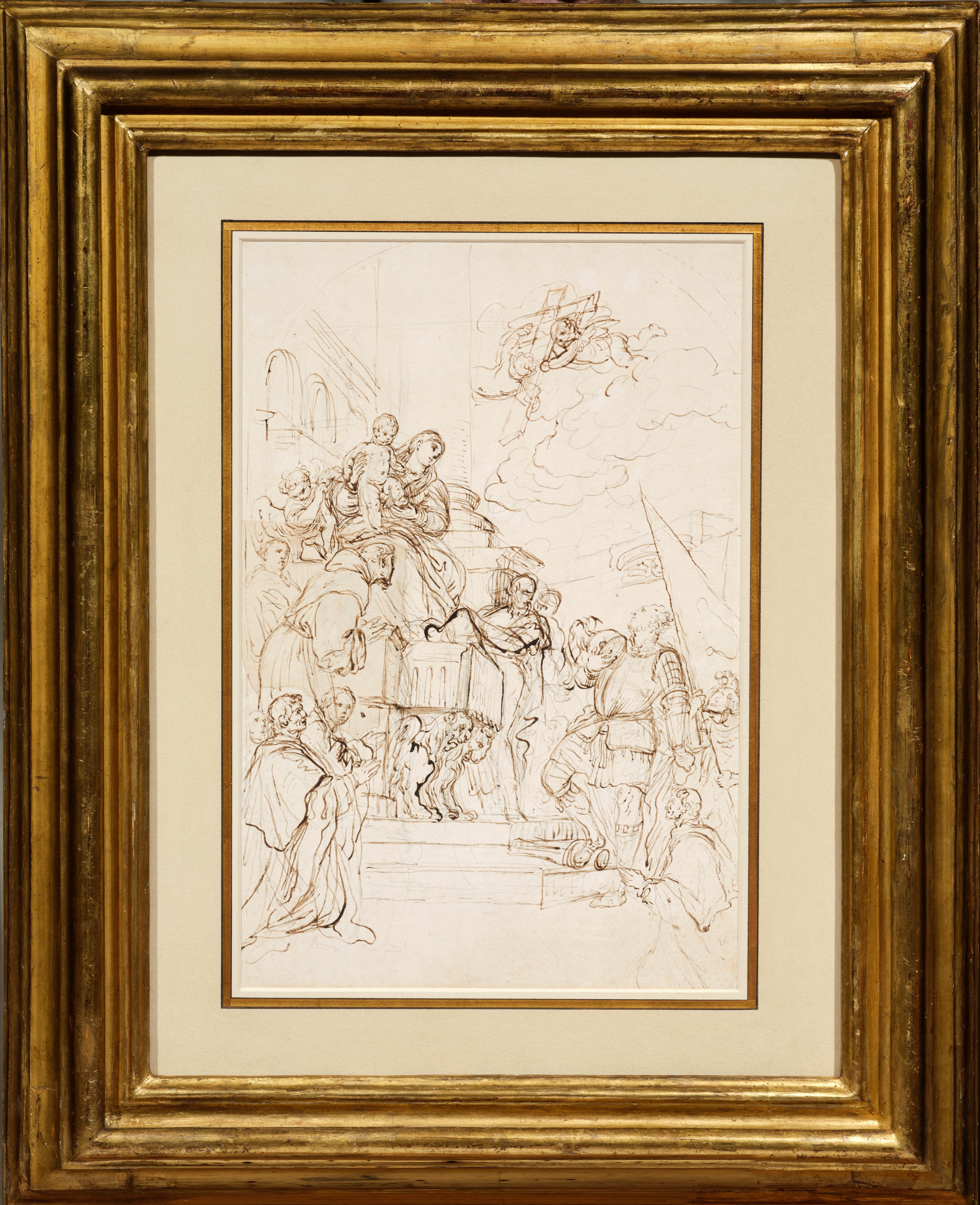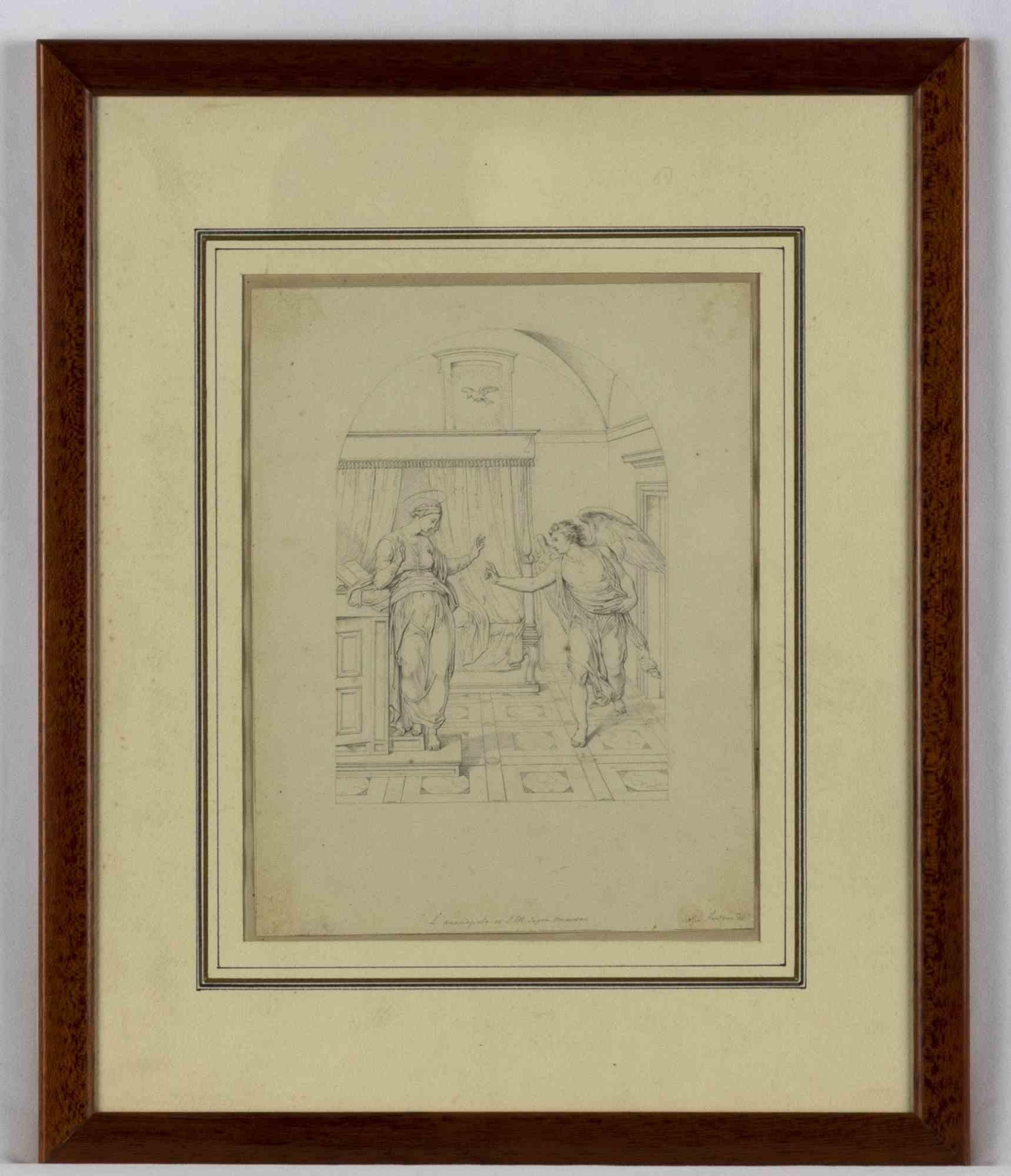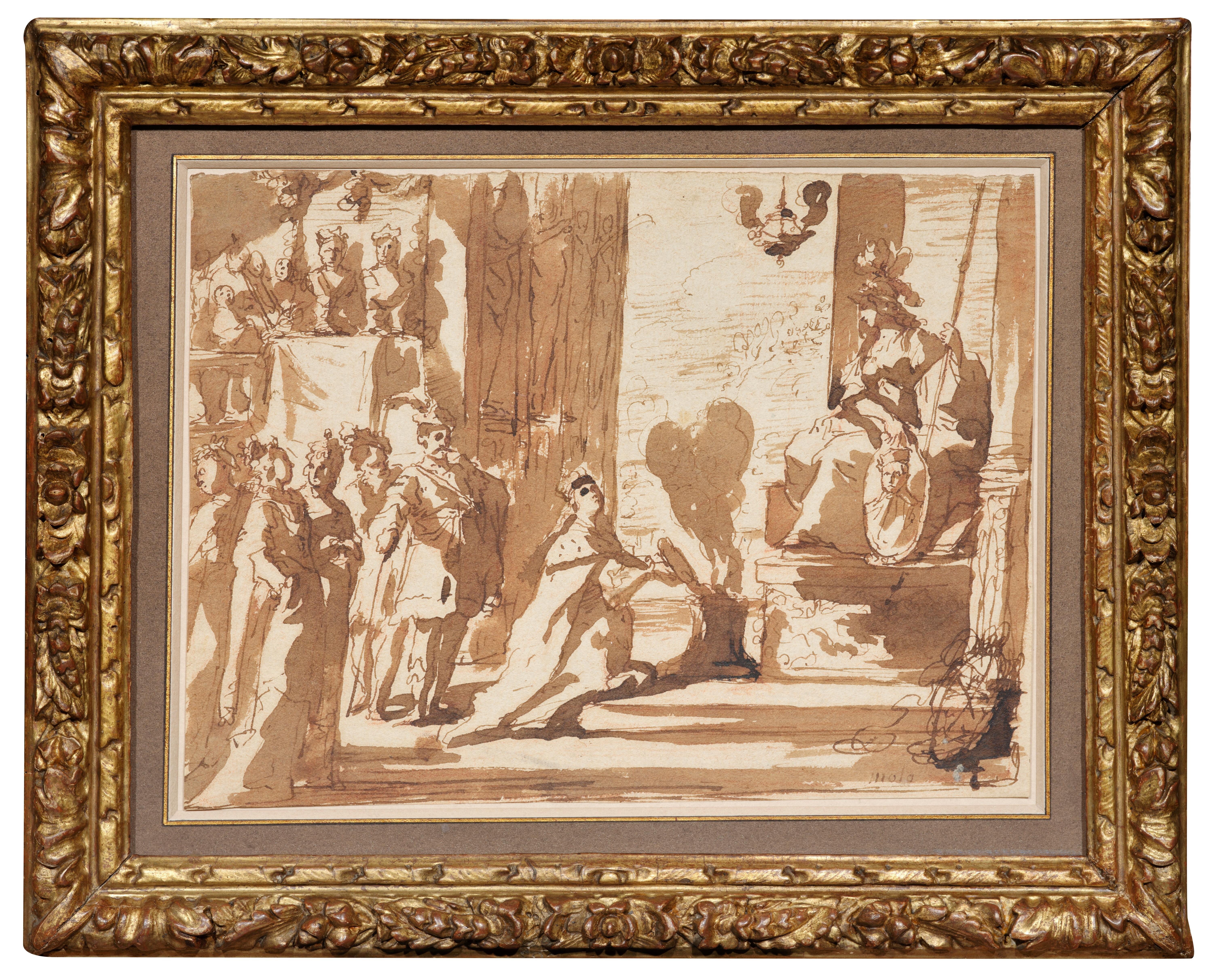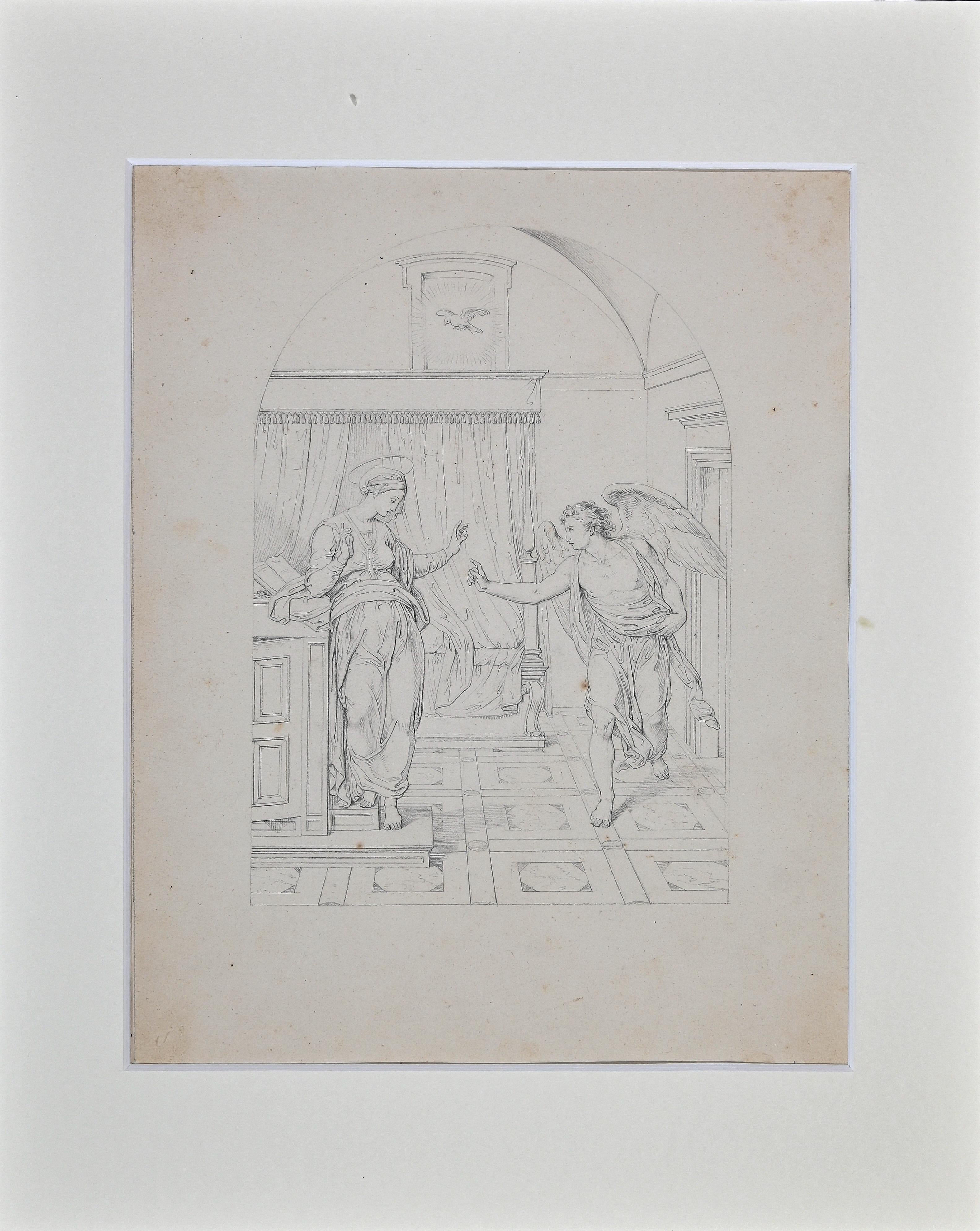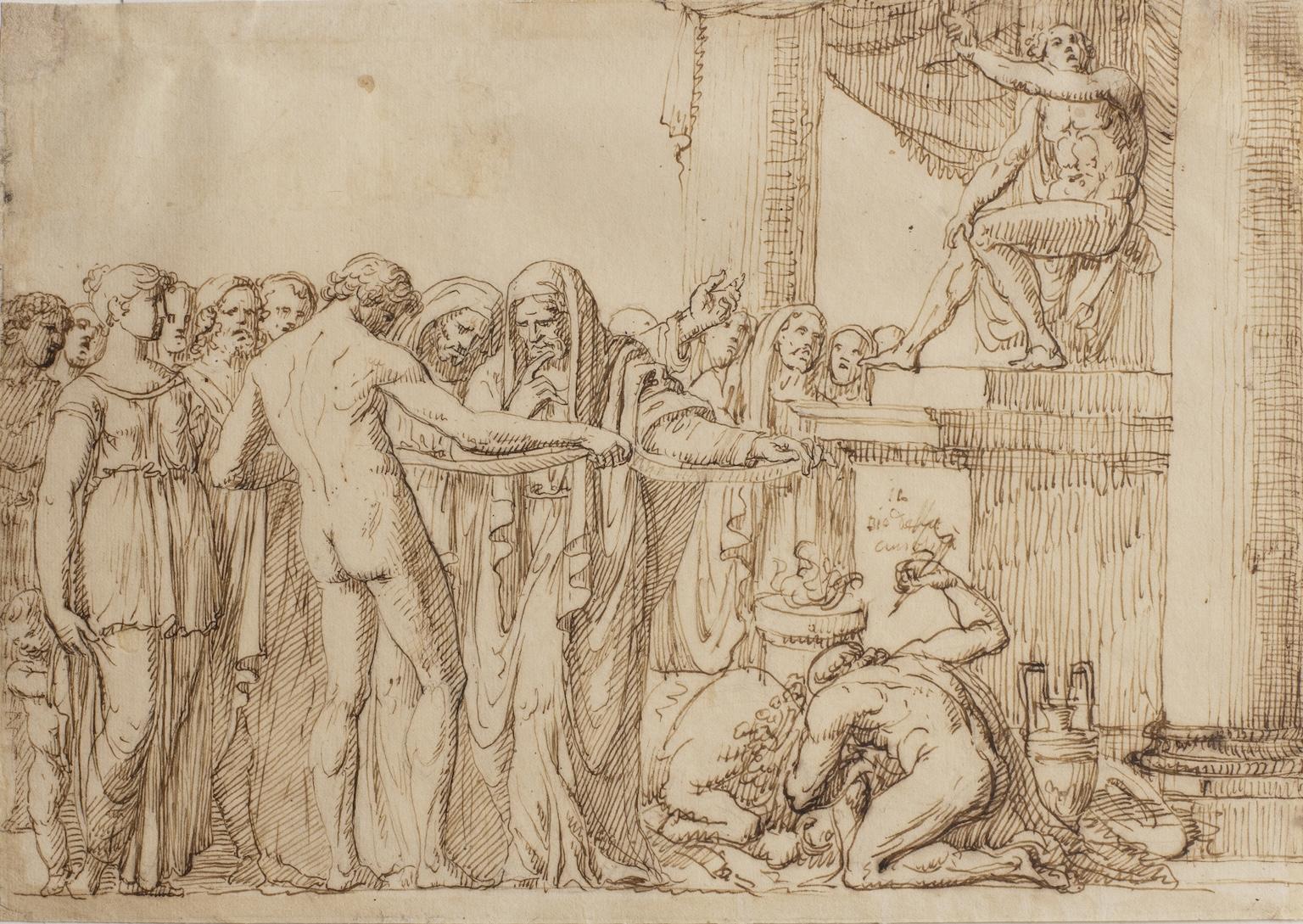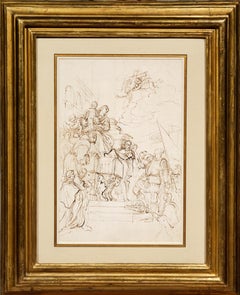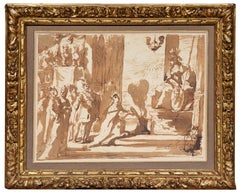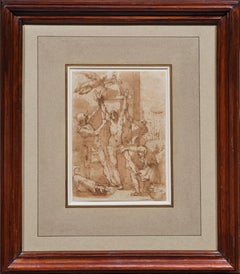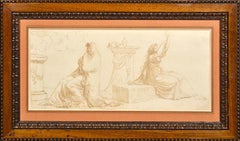Items Similar to Studies for the Judgment of Solomon, a double-sided drawing by Simone Cantarini
Want more images or videos?
Request additional images or videos from the seller
1 of 15
Simone CantariniStudies for the Judgment of Solomon, a double-sided drawing by Simone Cantarinica 1643-1648
ca 1643-1648
$17,290.70
£12,933.31
€14,500
CA$23,888.52
A$26,047.87
CHF 13,823.35
MX$314,910.36
NOK 174,944.47
SEK 160,360.94
DKK 110,466.06
About the Item
In this double-sided red chalk study, Simone Cantarini offers us a double reflection on the theme of the Judgment of Solomon. This sheet reveals his precise style and his sense of detail, which he combines here with a true Baroque inspiration in the composition.
1. The tumultuous life of Simone Cantarini, from the Marche to Guido Reni's studio in Bologna
Simone Cantarini was born in 1612 in Pesaro, in the Marches, a region which was a crossroads for artists from many parts of Italy. Cantarini began his artistic training quite young, probably 1623-1625, in the studio of Giovanni Giacomo Pandolfi (?1570-1640?), a painter of religious works who combined the local naturalism with the mannerist style of the late sixteenth century. After a brief trip to Venice, Cantarini moved to the shop of Claudio Ridolfi (?1570-1644), a student of Paolo Veronese (1528-1588). From Ridolfi he received training in the Venetian manner that was also a strong current in the local tradition, as well as a deep appreciation for the art of Federico Barocci (1535-1612), with whom Ridolfi had worked in Urbino. In about 1629 Ridolfi left Pesaro, forcing Cantarini to continue his studies on his own. In addition to prints by the Carracci, the young artist turned his attention increasingly to Barrocci and also to the caravaggesque, yet very personal, art of Orazio Gentileschi, who executed several works in the Marches during the 1610s, and of Giovan Francesco Guerrieri (1589-1657) from nearby Fossombrone.
As Malvasia recounts , the most significant event of Cantarini's youth was the arrival, probably in 1632, of Guido Reni's (1575-1642) Madonna and Child with Saints Thomas and Jerome in Pesaro Cathedral (now Pinacoteca Vaticana). Not content to study Guido's style from this work alone, Cantarini went to the church of San Pietro in Valle in nearby Fano to copy and draw after Guido's Giving of the Keys to Peter (now Louvre, Paris), completed 1626, and Annunciation of 1620-21. The young artist quickly assimilated Guido's style and soon received important commissions. Cantarini's desire to go to Bologna to study in Guido's studio was given additional impetus by an attempt on his life resulting from amorous exploits, which, Malvasia intimates, were inspired by a too careful study of the lascivious prints by the Carracci.
Upon his arrival in Bologna, probably in 1634 or 1635, Cantarini presented himself in Guido's studio as a painter of little training. His abilities soon became evident. Although Guido recognized that Cantarini was already a fully formed painter, he made the young man his most trusted pupil and secured him many commissions. Eventually, however, Cantarini's infamous pride and unbridled tongue came to the fore and alienated the master and the entire studio. One point of friction was Cantarini's refusal to use his considerable talents as an etcher to propagate Guido's designs, claiming that his own were equally worthy of publication. The decisive break came in 1637. From this point on, Cantarini's relations with his patrons also deteriorated rapidly, to the point where his commissions fell off almost entirely.
In 1639 Cantarini is documented at his sister's wedding in Pesaro. It must have been shortly thereafter, in 1640 or 1641, that he made a brief trip to Rome. Following Guido's death in 1642, Cantarini returned to Bologna, where he maintained a successful studio until his death in 1648 following a stay in Mantua. His behavior and criticisms of the Gonzaga collection created a scandal and it is suspected that he was poisoned by an angry rival.
2. Solomon's Judgment
This Old Testament scene is described in the First Book of Kings (3, 16-28). Two women had each given birth to a child, but one of them died of suffocation. They then fought over the surviving child. To settle the dispute, Solomon called for a sword and ordered the child to be cut in two. One of the women declared that she would rather give up the child than see him die, and Solomon thus recognized the child's true mother, to whom he was entrusted.
The masterly lesson of this judgment is to detach oneself from the seemingly satisfactory equality in order to seek true justice. Analysis of the emotions that led to the dispute (jealousy in the case of the non-mother, maternal instinct in the case of the mother) is more important than material evidence. Appeasement of the parties, the consequence of true justice, is based on the analysis of the underlying emotions. The real mother keeps her child, the jealous one is punished: evil intentions are defeated, love is rewarded. This story was often used to illustrate the precept that justice is not equality, sometimes in secular settings.
3. Drawing description
Although we consider the two scenes to be of equal interest, the drawing comes from an earlier collection in which it had received a window mount. The uneven tear of this mounting (which has been preserved) on the right indicates that this drawing was then presented with the signed side on the recto, and we have therefore retained this denomination, even if the drawing on the verso may seem more accomplished (and better centered!).
The fascinating feature of this drawing is that it is double-sided, "pivoting" (as we shall see) around the figure of the jealous mother, who is depicted from the front, arms outstretched to her left. This same figure is to the left of the soldier holding the child in the composition on the recto, and to the right of Salomon on the verso.
It seems to us that these two studies are like two moments in the same narrative: in the first instance (verso), the two women stand before King Solomon, seated on his throne, his arms outstretched in an imperious gesture. The standing woman is in an accusatory posture, while the other, crouching with one knee on the ground, is in a position of humble supplication.
The difference between these women's positions sheds light on the nature of the protagonists, and we recognize in this humble gesture the child's true mother, ready to do anything to save her child while the other mother slanders her.
In the scene depicted on the recto, the newborn's head has replaced Solomon's hand in the center of the composition. He is held by one leg by a soldier depicted in contrapposto.
Still kneeling, the real mother is now facing the soldier, whose arm she stops, while at the same time casting an imploring glance at Solomon on her right. The meaning of this gaze can only be understood in reference to the previous scene (it would have been more logical for her to be looking at the soldier), and we can imagine that the artist was looking for the layout of a large composition in which this group of two women with symmetrical movements would have been framed on her left by the soldier and on her right by Salomon.
4. Related artworks
Unfortunately, our research has not turned up any other work by Cantarini dealing with the same subject, as Old Testament subjects are quite rare in his graphic work. The artist's great ease in this drawing leads us to see it as a mature work (circa 1643 - 1648), when, having returned to Bologna after the death of Guido Reni, he ran a prosperous studio.
This drawing perfectly reflects the cross-over resonance, highlighted by Marina Cellini in her book on the Horne Album drawings , between Baroque heritage and the influence of Raphael, whose drawings he collected. Raphael’s influence is perceptible here in the "angelic" figure of the soldier.
The figure of Solomon and the torsion of the woman's back at the soldier's feet, with one bare shoulder, may evoke Valentin de Boulogne's Judgment of Solomon (10th photo in the gallery), painted around 1627 -1629 (two versions exist: one in the Louvre, the other in the Galleria Barberini in Rome), which Cantarini may have seen during his stay in Rome.
5. Simone Cantarini's graphic work
Simone Cantarini was a prolific draughtsman, and his numerous drawings are held in major public collections around the world. The red chalk technique used in the drawing presented here is typical of the artist, as illustrated by the drawing of Venus and Adonis in the Musée du Louvre reproduced below (last photo in the gallery).
A particularity of Cantarini's drawings is that they were often preserved in albums, like the sheet we are presenting here. The drawings from his Bolognese studio were purchased en bloc by a number of local collectors, while others were inherited by his family in Pesaro and then sold as a group to local collectors. These collections have been subsequently dismembered.
In her book on the Horne Album (a set of 44 drawings, mostly by Cantarini, probably bought in England around 1818-1820 from Marquis Antonio Antaldi and since reassembled in a single album now owned by the Horne Foundation in Florence), Marina Cellini mentions a number of important historical collections that have partly survived in public collections: that of the Pesaro library (also said to have come from Marquis Antaldi’s), that of the Rio de Janeiro Museum (!), purchased en bloc by José da Costa e Silva from the Fava family of Bologna, or that of the Pinacoteca Brera in Milan, which came from the collector Filippo Acqua (1737-1808), who himself acquired them from one of Cantarini's heirs.
Our sheet features various annotations in the upper margins, which may shed light on its provenance by comparison with other drawings with similar annotations (unfortunately, none of the above-mentioned collections have been digitized to date).
6. Framing
This red chalk drawing has been framed in a 17th-century Bolognese frame. The mount is double-sided, allowing the drawing to be displayed either on the verso or on the recto, while the unexposed side, also protected by glass, can be seen on the back of the frame.
- Creator:Simone Cantarini (1612 - 1648, Italian)
- Creation Year:ca 1643-1648
- Dimensions:Height: 18.5 in (46.99 cm)Width: 16.94 in (43.03 cm)
- Medium:
- Movement & Style:
- Period:1640-1649
- Condition:Dimensions : 8 3/4‘’x 7 5/8 ‘’ (222 x 193 mm) (framed 18 1/2’’ x 16 15/16’’- 47 x 43 cm) Signed at the bottom with ink "Pesares" Frame: 17th-century Bolognese frame in carved and gilded wood.
- Gallery Location:PARIS, FR
- Reference Number:1stDibs: LU1568216519142
About the Seller
5.0
Vetted Professional Seller
Every seller passes strict standards for authenticity and reliability
Established in 2020
1stDibs seller since 2021
10 sales on 1stDibs
Typical response time: <1 hour
- ShippingRetrieving quote...Shipping from: PARIS, France
- Return Policy
More From This Seller
View AllFrom Renaissance Venice to Barocco Naples, a drawing by Francesco La Marra
Located in PARIS, FR
This vigorous drawing presents a brilliant synthesis between the Venetian tradition of Titian, of which it is a distant echo, and the Neapolitan Baroque of Solimena, which strongly i...
Category
Mid-18th Century Old Masters Figurative Drawings and Watercolors
Materials
Paper, Ink, Felt Pen
Allegory of the Treaty of Angoulême, a drawing attributed to Donato Mascagni
Located in PARIS, FR
We would like to thank Mrs. Ursula Verena Fischer Pace for suggesting the attribution to Donato Arsenio Mascagni.
We were immediately seduced by the rich tonalities of this allegory...
Category
1620s Old Masters Figurative Drawings and Watercolors
Materials
Ink
The Martyrdom of Saint Bartholomew, a preparatory drawing by Alessandro Casolani
Located in PARIS, FR
This powerful pen and brown ink wash drawing is a study for an altarpiece depicting The Martyrdom of Saint Bartholomew. Signed and dated 1604, it was painted at the end of his life b...
Category
Early 1600s Old Masters Figurative Drawings and Watercolors
Materials
Ink, Pen
A rare neoclassical drawing by Jean-Pierre Péquignot, Girodet's friend
Located in PARIS, FR
This neoclassical frieze, executed with great meticulousness in pen and ink, is a moving and rare testimony to the work of Jean-Pierre Péquignot, an extremely talented and particular...
Category
1790s Old Masters Figurative Drawings and Watercolors
Materials
Paper, Ink, Felt Pen
Study for a Frontispiece, a baroque drawing by Giovanni Antonio Pellegrini
By Giovanni Antonio Pellegrini
Located in PARIS, FR
This masterly frontispiece study, executed with a very sure hand, testifies to the survival of the great Baroque taste in 18th century Venice. It could be one of the very last works by Giovanni Antonio Pellegrini: the few lines that cross the papal arms evoke those of Benedict XIV, who became pope in 1740, one year before the artist's death.
1. Giovanni Antonio Pellegrini and the European influence of Venetian history painting in the 18th century
Giovanni Antonio Pellegrini was born in Venice in 1675 and trained in the studio of the Milanese painter Paolo Pagani (1655 - 1716). Pagani, who had been living in Venice since 1667, took him to Moravia and Vienna from 1690 to 1696. After a stay in Rome from 1699 to 1701, Pellegrini married Angiola Carriera in 1704, the sister of the great pastelist Rosalba Carriera.
From 1708 onwards, Pellegrini left Venice and began an extensive tour of Europe: he worked in England between 1708 and 1713, where he met great success, particularly at Kimbolton Castle and Castle Howard. He then worked in Germany and the Netherlands, then in Bohemia and Austria, before returning briefly to England in 1719. In 1720 he was in Paris where he decorated the ceilings of the Royal Bank for John Law...
Category
1740s Old Masters Figurative Drawings and Watercolors
Materials
Ink
Allegory of Chastity, a drawing attributed to G. Porta with great provenance
Located in PARIS, FR
This magnificent drawing from the Venetian Renaissance intrigues us in many ways. It depicts an allegorical composition whose meaning partly escapes us: a veiled figure seated on a stone bench (which we have identified as Chastity), seems to be turning away from a woman's bust beside her, below which are two rabbits, a traditional allegory of fertility, but also sometimes of lust.
This drawing, executed on blue paper, undoubtedly belongs to the Venetian Renaissance. The inscriptions on the back of the old mounting board indicate the various attributions considered by its last owner, the British painter and art historian Sir Lawrence Gowing. We have retained the attribution to Giuseppe Porta proposed by art historian John Arthur Gere as the most relevant.
We were incredibly fortunate to find a hexagonal frame of a very similar format for this drawing, the upper corners of which were formerly cut (irregularly). This 17th-century Dutch frame comes from an aristocratic collection in Lombardy, and creates a kind of fascinating chase around this Venetian drawing...
Category
16th Century Figurative Drawings and Watercolors
Materials
Chalk
You May Also Like
L'Annunziata in S. M. - Drawing by Giovanni Fontana - 16th Century
By Giovanni Fontana
Located in Roma, IT
L'Annunziata in S. M. sopra Minerva is an original old master artwork realized by Giovanni Fontana.
Ivory colored sheet attached on an ivory colored cardboard ( cm 35.8 x 26.7)
Bea...
Category
16th Century Old Masters Figurative Drawings and Watercolors
Materials
Paper, Pencil
$4,382 Sale Price
25% Off
Tuscan allegorical figurative drawing pencil on paper, 19th century
Located in Florence, IT
This small study on paper, 18 x 21 cm, depicts a group of nude putti, about 7 of them, in small groups engaged in various activities, of which we can recognize that of the three in t...
Category
19th Century Romantic Figurative Drawings and Watercolors
Materials
Paper, Pencil
The Announcement - Drawing by Giovanni Fontana - 16th Century
By Giovanni Fontana
Located in Roma, IT
The announcement in S. Maria sopra Minerva is an original drawing in pencil on paper, realized by Giovanni Fontana.
The state of preservation of the artwork is good except for some ...
Category
16th Century Figurative Drawings and Watercolors
Materials
Paper, Pencil
Figurative drawing neoclassical Tuscan historical subject from the 19th century
By Francesco Nenci
Located in Florence, IT
The proposed attribution for this drawing in brown ink on paper is the name of the painter and academician of the Tuscan-Roman neoclassical cohort Francesco Nenci (Anghiari, April 19...
Category
Early 19th Century Other Art Style Nude Drawings and Watercolors
Materials
Paper, Ink
Italian School, 17th Century - Study After The Frescoes Of Bernardino Lanino
Located in Paris, Île-de-France
Italian School, 17th century
Study after Bernardino Lanino’s Frescoes in Santa Caterina, Milan
Red chalk on paper
297 x 186 mm
Annotated on the verso: “Vani” (otherwise unsigned)
...
Category
17th Century Old Masters Interior Drawings and Watercolors
Materials
Chalk, Laid Paper
Old Masters Chalk Drawing, 17th Century Italian Sanguine on Paper
Located in London, GB
Sanguine chalk on paper
Image size: 7 x 8 1/2 inches (18 x 22 cm)
Acid free cut-out mount
This 17th century drawing depicts a reclining woman with her back.
The Sanguine chalk that...
Category
17th Century Italian School Figurative Drawings and Watercolors
Materials
Paper, Chalk
